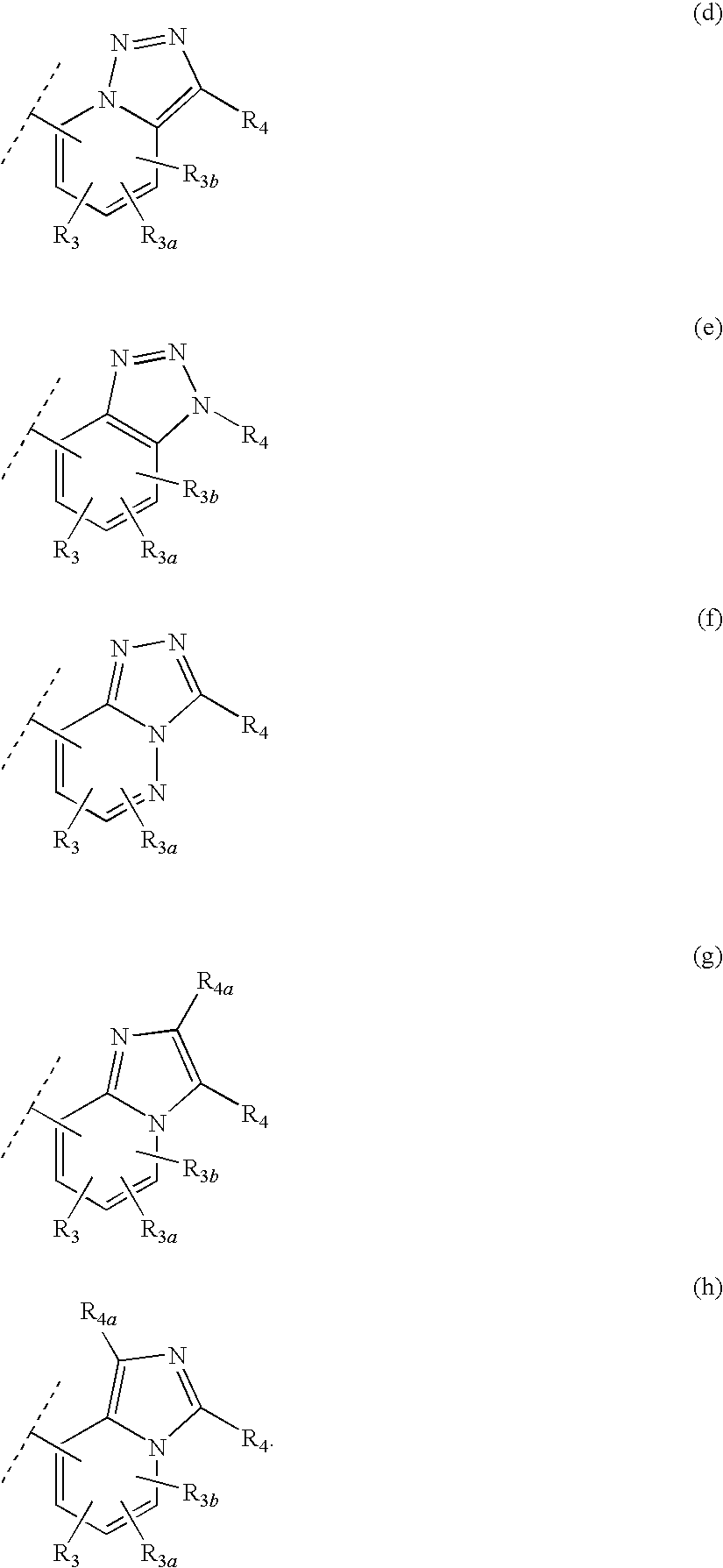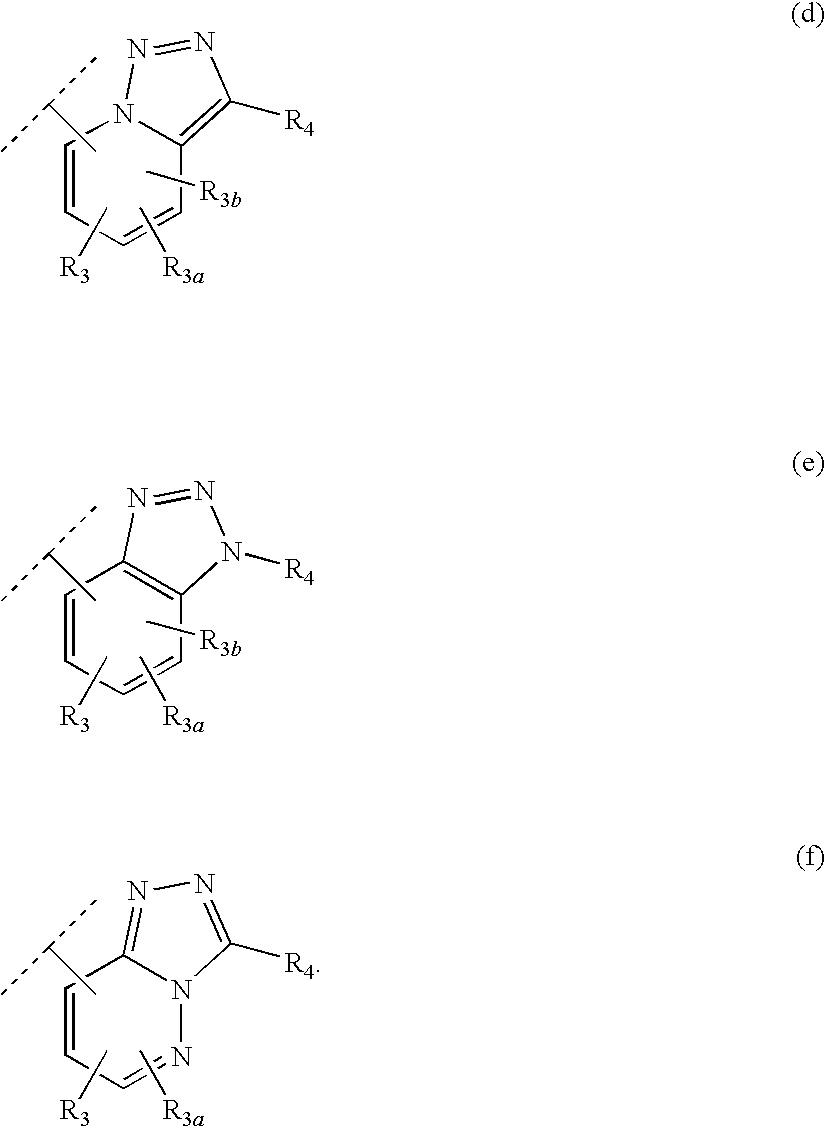Heteroaryl 11-beta-hydroxysteroid dehydrogenase type I inhibitors
a technology of heteroaryl 11beta hydroxysteroid and inhibitor, which is applied in the direction of antibacterial agents, drug compositions, metabolic disorders, etc., can solve the problems of severe metabolic abnormalities, but no significant increase in plasma cortisol levels
- Summary
- Abstract
- Description
- Claims
- Application Information
AI Technical Summary
Problems solved by technology
Method used
Image
Examples
example 1
[0343]To a solution of compound 1D (50 mg, 0.12 mmol) in 2 mL of anhydrous toluene was added POCl3 (23 μL, 0.25 mmol) at RT. The reaction mixture was heated at 100° C. for 3 hr, cooled to RT and quenched with water. The reaction mixture was then diluted with ethyl acetate, washed with water, dried over Na2SO4 and concentrated under reduced pressure to yield crude product. The crude product was purified via PrepHPLC to provide Example 1 as a colorless oil (43 mg, 66%). HPLC Rt (Method A): 3.00 min. LC / MS (m / z)=389 (M+H)+. 1H NMR: δ 8.01 (s, 1H), 7.90 (d, J=7 Hz, 1H), 7.34 (d, J=8 Hz, 2H), 7.29 (d, J=7 Hz, 1H), 7.08 (t, J=8 Hz, 1H), 7.02 (t, J=7 Hz, 1H), 5.17 (s, 2H), 3.39-3.50 (m, 1H), 2.02-2.18 (m, 4H), 1.88-2.00 (m, 2H), 1.56-1.78 (m, 6H).
Example 2
3-Cycloheptyl-8-((2,6-dichlorophenoxy)methyl)H-imidazo[1,2-a]pyridine
[0344]
Compound 2A: 2-Bromo-1-cycloheptylethanone
[0345]
[0346]To a solution of cycloheptanecarboxylic acid (1.5 g, 10.5 mmol) in 5 mL of dichloromethane was added oxalyl c...
example 2
[0349]To a solution of compound 2B (73 mg, 0.3 mmol) in 2 mL of anhydrous THF was added 2,6-dichlorophenol (98 mg, 0.6 mmol), triphenylphosphine (157 mg, 0.6 mmol) and DEAD (105 mg, 0.6 mmol) at RT. The reaction mixture was stirred at RT for 2 hr, and then concentrated under reduced pressure. The concentrated reaction mixture was diluted with ethyl acetate, washed with water, dried over Na2SO4 and concentrated under reduced pressure to yield crude product. The crude product was purified via silica gel chromatography using 30% ethyl acetate in hexanes followed by PrepHPLC to yield Example 2 as a pale-yellow oil (56 mg, 37%). HPLC Rt (Method A): 3.00 min. LC / MS (m / z)=389 (M+H)+. 1H NMR: δ 8.25 (d, J=8 Hz, 1H), 8.20 (d, J=8 Hz, 1H), 7.46 (d, J=1 Hz, 1H), 7.35 (t, J=8 Hz, 2H), 7.31 (d, J=8 Hz, 1H), 7.04 (t, J=8 Hz, 1H), 5.57 (s, 2H), 3.15-3.25 (m, 1H), 2.08-2.18 (m, 2H), 1.50-1.80 (m, 10H).
Example 3
3-Cycloheptyl-7-((2,6-dichlorophenoxy)methyl)-[1,2,3]triazolo[1,5-a]pyridine
[0350]
Compoun...
example 3
[0361]Example 3 (66 mg, 92%, white powder) was prepared from compound 3E in a similar manner as described for the preparation of Example 2 from compound 2B. HPLC Rt (Method A): 4.26 min. LC / MS (m / z)=390 (M+H)+. 1H NMR: δ 7.72 (d, J=8 Hz, 1H), 7.44 (d, J=1 Hz, 1H), 7.37 (d, J=8 Hz, 2H), 7.26-7.32 (m, 1H), 7.10 (t, J=8 Hz, 1H), 5.68 (s, 2H), 3.30-3.40 (m, 1H), 1.96-2.15 (m, 4H), 1.83-1.93 (m, 2H), 1.60-1.82 (m, 6H).
Example 4
1-Cycloheptyl-4-((2,6-dichlorophenoxy)methyl)-1H-benzo[d][1,2,3]triazole
[0362]
Compound 4A: Azidocycloheptane
[0363]
[0364]To a 250 mL round bottle flask containing cycloheptyl bromide (10 g, 56.47 mmol) in 30 mL of THF was added trimethylsilyl azide (9.76 g, 84.7 mmol), followed by addition of a solution of 1.0 N TBAF in THF (84.7 mL, 84.7 mmol). The reaction mixture was heated at 70° C. for 6 h. After this time, the solvent was removed under reduced pressure, and the reaction mixture was purified via silica gel chromatography using pentane to provide compound 4A (7....
PUM
| Property | Measurement | Unit |
|---|---|---|
| temperature | aaaaa | aaaaa |
| enantiomers | aaaaa | aaaaa |
| diastereomers | aaaaa | aaaaa |
Abstract
Description
Claims
Application Information
 Login to View More
Login to View More - R&D
- Intellectual Property
- Life Sciences
- Materials
- Tech Scout
- Unparalleled Data Quality
- Higher Quality Content
- 60% Fewer Hallucinations
Browse by: Latest US Patents, China's latest patents, Technical Efficacy Thesaurus, Application Domain, Technology Topic, Popular Technical Reports.
© 2025 PatSnap. All rights reserved.Legal|Privacy policy|Modern Slavery Act Transparency Statement|Sitemap|About US| Contact US: help@patsnap.com



